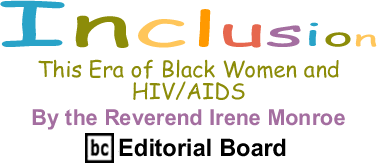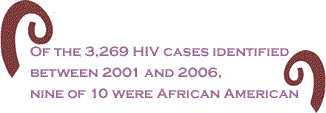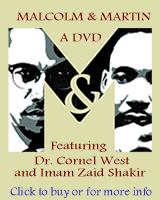Black women are dying of AIDS, and is anyone doing anything about it?
With last week commemorating the 19th Anniversary of World AIDS Day and the
United Nations' AIDS-fighting agency overestimating the global impact of
the epidemic by six million people, we would think we’ve seen the worst
of this pandemic.
Not quite! Right here in the nation’s capitol, the HIV/AIDS epidemic
rivals that of many Third World countries. Washington D.C., affectionately
dubbed as “Chocolate City,” is approximately 60 percent people
of African descent. And of its residents, one in 20 is thought to have HIV
and 1 in 50 is thought to have AIDS. Of the 3,269 HIV cases identified between
2001 and 2006, nine of 10 were African American.
Are these statistics overwhelming?
“The Washington data is really a microcosm of what we already know: that
AIDS in America today is a black disease,” said Phil Wilson, founder of
the Black AIDS Institute, an HIV/AIDS think tank that focuses exclusively on
AIDS among black Americans.
According to the U.S. Centers for Disease Control and Prevention, African
Americans account for half of all new HIV cases, despite comprising 13 percent
of the U.S. population. Equally alarming is that HIV/AIDS is the leading
cause of death for African American women between the ages of 25 and 44.
At the “Women and Response to AIDS” panel at the 16th International
AIDS Conference in Toronto in 2006, Sheila Johnson, founder of the Crump-Johnson
Foundation in Washington D.C., pointed out that another at-risk population
in the African American community is teenage girls.
Seventeen percent of the U.S. teen population is African American. In
2004, 70 percent of all teens testing HIV-positive were black. One in
10 African
American teenage girls test HIV-positive in the nation’s capital, the
highest percentage in the country among this age group.
When asked why such a high percentage test positive, Johnson said, “As
long as girls see themselves as glorified sex objects in hip-hop videos,
HIV/AIDS will increase within this population.”
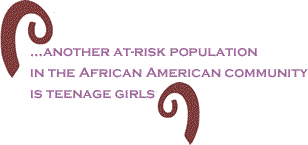
Are these statistics overwhelming?! But so, too, is the failure
of leadership African Americans have faced since the epidemic
began. And no group of women
is as affected by the failure of leadership in this country than women
of African descent.
American women and their struggle against the AIDS epidemic was never
so glaringly obvious than in the 2004 vice presidential debate between
Dick
Cheney and John Edwards. The invisibility of my group's plight has less
to do with African-American women's agency to combat the epidemic than
with
how the government, African-American men, the Black Church, and race and
gender biases inherent in the problem collude with African-American women's
efforts to get help.
Gwen Ifill, an African-American female journalist with PBS' Washington
Week and moderator of the vice presidential debate, brought the issue
of AIDS in the U.S. front and center when she asked the men to comment
on its devastating impact on African-American women.
"I want to talk to you about AIDS, and not about AIDS in China or Africa,
but AIDS right here in this country, where black women between the ages of 25
and 44 are 13 times more likely to die of the disease than their counterparts.
What should the government's role be in helping to end the growth of this epidemic?" Ifill
asked.
Vice President Cheney responded to Ifill's question by saying, "Here
in the United States, we've made significant progress. I have not heard those
numbers with respect to African-American women. I was not aware that it was
- that they're in epidemic there." Edwards' response wasn't any better.
Edwards deflected the question by first going back to answering the previous
question. Then with the remaining seconds left, he flubbed his way through.
However, three years later, at this June’s Democratic Primary Debate
at Howard University that focused on African American issues ranging from
health care and housing to Katrina relief, the economy and the environment,
Black women stood on their feet as they applauded Sen. Hillary Clinton’s
comment about the impact of HIV/AIDS on African American women. "Let
me just put this in perspective: If HIV-AIDS were the leading cause of
death of white women between the ages of 25 and 34 there would be an outraged
outcry
in this country."
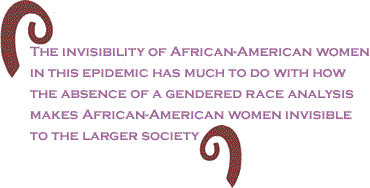
When the color of the epidemic shifted from white to black,
the inherent gender bias focused only on the needs of African-American
men and rendered
women invisible. And when gender became a new lens to track the epidemic,
white women were the focus. The invisibility of African-American women
in this epidemic has much to do with how the absence of a gendered
race analysis
makes African-American women invisible to the larger society.
What is also unnerving is that today, African American women make
up 60 percent of all AIDS cases reported among women, 64 percent
of new
AIDS cases among
women, and are three times the number of new cases reported among white
women.
Many African-American women with HIV contracted it from heterosexual
sex. And two ways that the virus is contracted heterosexually is
through intravenous
drug use and African-American men "on the down low." But men
living on the DL is not a new phenomenon in the African-American community.
Naming
it, however, is. And it was J.L. King who became the country's poster
boy by exposing the behavior in his best-seller, On
the Down Low: A Journey into the Lives of "Straight" Black Men
Who Sleep with Men .
.
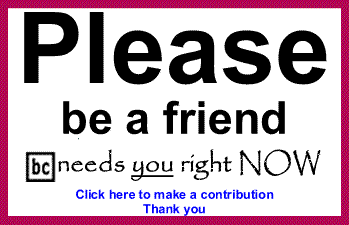
"There are many women, too many women, in relationships with men who they
think they know but really don't. He knew he had the disease, his mother knew
he had the disease, his doctors knew, everyone seemed to know except me. And
no one said a word," LaJoyce Brookshire wrote in the foreword of Browder's
book, herself author of Faith
Under Fire: Betrayed by a Thing Called Love . While
homophobic attitudes in the larger African-American community and church
contribute to their behavior, African-American men are also not taking responsibility
for how their behavior is killing African-American women, and putting the
entire
community at risk.
. While
homophobic attitudes in the larger African-American community and church
contribute to their behavior, African-American men are also not taking responsibility
for how their behavior is killing African-American women, and putting the
entire
community at risk.
The disparities within the healthcare system also contribute to the disproportionately
higher number of HIV cases among African-American women, and this directly
affects their quality of life and the spread of HIV. While healthcare
disparities in the black community are overwhelming, so too is the failure
of leadership
that African Americans have faced since the epidemic began.
“The story of AIDS in America is mostly one of a failure to lead, and nowhere
is this truer than in our black communities,” said Julian Bond, chairman
of the NAACP, at the 2006 International AIDS Conference in Toronto.
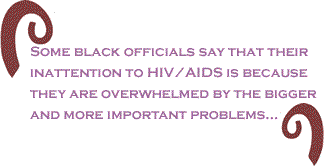
But Phil Wilson states it plainly: “I think it’s important for
us to take just a moment to realize that we are where we are today because
we weren’t concerned when we thought it was somebody else’s
disease.”
However, the disease has also taught us about the various faces
- across race, class and gender - who wore and continue to wear
the
face of this
disease.
When The New York Native, a now-defunct gay newspaper,
in its May 18, 1981, issue first reported on a virus found in gay
men
then known as
GRID (Gay-Related Immune Deficiency), an editorial noted that "even
if the disease first became apparent in gay men, it is not just 'a gay disease.'" And
HIV/AIDS, having neither an alliance to nor an affinity for queer sexualities,
spread.
But where would the leadership on HIV/AIDS come from? Our African
American lawmakers?
While a few of our local African-American elected officials and
the Congressional Black Caucus have spoken up about the AIDS epidemic
in the black community,
the non-involvement by the majority of them has been scandalous. Some
black officials say that their inattention to HIV/AIDS is because
they are overwhelmed
by the bigger and more important problems affecting inner-city urban
life such as crime, gang warfare, homelessness, drugs and poverty.
While some
black elected officials have voted for money for AIDS programs, they
have generally resisted providing the leadership needed to mobilize
black and
Hispanic groups to stem the spread of HIV/AIDS.
 But let’s confront the elephant in the black community, by
telling the truth and shaming the devil.
But let’s confront the elephant in the black community, by
telling the truth and shaming the devil.
The biggest problem that black lawmakers have had to confront concerning
the HIV/AIDS crisis in their communities is the political gag order
imposed on them by their voting constituency’s homophobia
and animus toward any discussion of the disease.
Would the leadership on HIV/AIDS come from the black church?
When it comes to the black church and HIV/AIDS, I am always reminded
of what my mayor in Cambridge, Mass., Ken Reeves, who is both African
American and
gay, told The Washington Blade in March, 1998, during a two-day
Harvard University HIV/AIDS conference: “African American male ministers
over 40 are a tough nut to crack. If we wait for the black church on this,
we’ll all be dead.”
The Black Church continues to play a part in the death of African
Americans with AIDS. While its silence on the issue is appalling
and unconscionable,
so too is its various forms of heterosexualized rituals and pronouncements
that denigrate both LGBT people and women. A study by the Pew Forum
on Religion and Public Life showed that since 2000, African-American
Protestants are
less likely than other Protestant groups to believe that LGBT people
should have equal rights. And since hot-button issues like gay
adoption
and marriage
equality have become more prominent, support for LGBT rights among
African-American Protestants has dipped as low as 40 percent.
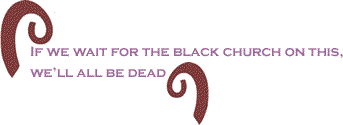
Therefore, women with AIDS are as unwelcome in the Black
Church as LGBT people. Within Black Nationalist milieus like
the Black
Church
and the
Nation of
Islam, African-American women with AIDS are also viewed as race traitors.
In this patriarchal straightjacket, biological essentialist views
are as holy and deified as the Bible itself. And with the
belief that
women are
to multiply and bring forth new life for the perpetuation of the
race, women with AIDS lose their status in the community.
Often labeled
as "loose" for
having contracted the virus, she is viewed as not only diseased but
also dangerous because her sexual wiles continue to seduce men.
A woman with
AIDS is a fallen woman, not only for having contracted the disease,
but also for
having disregarded the policing of sexual behavior by the Black Church.
While some women have felt shamed and stigmatized by the Black
Church for contracting the virus and have stayed away, many more
have fought
back with
a righteous indignation. One of our sister warriors in Boston, Belynda
Dunn, who died of AIDS in March, 2002, at the age of 49, had
done so. As a tireless
AIDS activist, Dunn was the founder and director of the multicultural
multidisciplinary Who Touched Me Ministry, an initiative to educate
black churches in stopping
the spread of HIV/AIDS in their communities. She was the HIV Prevention
Manager and Educator for the Boston-based AIDS Action Committee.
As a heterosexual African-American woman, Dunn was the wake-up
call to the African-American community and the Black Church that
HIV/AIDS
is not solely
a gay disease, but an equal opportunity virus. In her tireless effort
to get the Black Church to see this epidemic through her as a
Christian heterosexual
female, Dunn became the driving force behind making the African-American
community confront its homophobia and AIDSphobia.
"Belynda really lit a fire under me. That's what Belynda did with everyone.
She really helped us cross ideological lines and theological lines and not get
hung up on the homosexual issue. She said to the Black Church: 'Get over it,'" according
to Dunn's pastor, the Rev. Martin McLee of Union United Methodist Church
in Boston's South End, the only African-American church in Boston welcoming
of
its LGBT and
HIV-positive members.
"She was known for her strength, her charisma and her vision. She had the
ability to fight even when no one was listening. She was able to cut through
the levels of denial. She wanted to turn this epidemic around and her vehicle
to do that was the Black Church," AIDS Action's then-executive director,
Larry Kessler, told a newspaper back in 2002. Ironically, she died the
week when black churches in the greater Boston area held AIDS prayer
services, but sadly,
most black churches still turned a deaf ear to Dunn's call for action.
In African-American communities across this country, the disease
still shows no sign of abating. Black cadaverous bodies have hid
and still
hide from
the community and each other. And with its harsher judgment against
women with HIV/AIDS, African-American women are less likely than
any other
group to seek help.
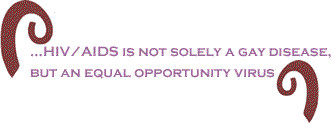
Although many of us in black communities averted our eyes,
pretending we did not see them, we all saw them. We all knew
them, and we
all, in silence,
watched them die because we have still done nothing to stem the
epidemic.
In my pastoral study one day, I heard a faint knock on my door.
I yelled to come in, but the person just stood there on the
other side
of the door
from me. Thinking it was one of the kids from Sunday School horsing
around, I continued with my work. Then, minutes later, again
the faint knock.
Annoyed and now certain that it was one of the kids, I rose
from my seat with the intention to tell the kid to stop. I
swung open
the door
and to
my surprise there stood in front of me a vaguely familiar image.
Kaposi's sarcoma lesions were splattered about on this woman's
face and neck.
Her eyes were sunken with dark rings, and she was 40 pounds
thinner. A one-time
big and vibrant Afro (the community had nicknamed her Sister Angela
Davis) had been transmuted into straight, willowy thin hair,
and was almost
gone. I greeted her as if she were a stranger. When she told
me who she was,
I had to fight back the tears.
Desperate to see me because she heard I did not discriminate
in doing funerals for those who died with AIDS, Bernice (not
her real
name)
felt her prayer
could be answered. Bernice wanted to set up her funeral arrangements.
And we did. Approximately three months from the day I heard
her faint knocks
on the door, Bernice died.
Before she died, Bernice helped me to set up weekly weekend
workshops in the community on sexuality and spirituality for
both churched
and unchurched
African-American women with HIV/AIDS. And Bernice was in most of
them. Too weak, however, in the final weeks of her life to
participate and to speak
up in the workshops, Bernice just sat quietly in her wheelchair,
speaking
to us with her head movements. She listened to the women tell about
their lives as black women, their lives as black women with
black bodies no
one respected, and their lives as black women with black bodies
presently living
with HIV/AIDS that no one wanted to touch. During each workshop,
we all cried. We cried for ourselves and each other. We cried
for
the many
black women
we knew with HIV/AIDS. We cried for the many black women we knew
with HIV/AIDS who did not have a support group. And we cried
because
for some, the workshop
was one of a few times in their lives they felt safe to cry.
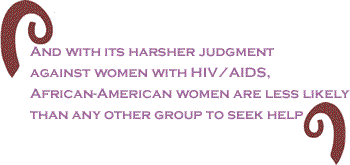
The feminization of this disease makes many of us AIDS activists
and scholars wonder if the same amount of money, concern,
communication, and moral outrage
that was put into white gay men with the disease will be put
into curbing its spread among black women. "What do we need to know to provide better
HIV and AIDS prevention services to African-American women?" Dr. Gerri
Outlaw, an African-American lesbian and chair of the Department of Social
Work at the College of Health Professions at Governors State University in
Illinois, asked in 2005, leading to setting up the pilot project "Women
Making Meaning of HIV and AIDS in Economically Marginal African-American
Communities: Implications for Community-Based Education."
Recognizing
the paucity of funds and prevention strategies targeted to
African-American women with HIV/AIDS, Outlaw stated she "wanted
to examine community-based approaches to HIV/AIDS prevention
and education for black women. Few if any services were on
the west side of Chicago and women had to go to white gay
areas to get services, and the treatment and prevention services
were not for women, period."
The AIDS epidemic among African-American women is also symptomatic
of the dialogue we need to have about our bodies and sexuality,
which has been choked
for centuries by a "politic of silence." In aiming to break through
the "politic of silence" with her pilot project, Outlaw began interviewing
mothers, daughters and grandmothers in order to access the beliefs, attitudes,
experiences and perceptions of HIV/AIDS among ordinary African-American women.
"I began to talk to women about how they learned about sex in the first
place. I asked what role mothers and daughters play in communication about sex.
I wanted to know how much young women learned from their mothers, and I wanted
to know whether others were having conversations without their daughters in light
of HIV and AIDS."
But having a conservation is hard, especially for young women.
“Many of us sistas find talking about sex difficult. Our partners may get
angry or defensive. They sometimes feel that we are accusing them of something
or that we don't trust them. Talking is especially hard when a young woman has
an older partner because the older partner tends to have more power in the relationship.
Often, we look to the older partner for information about protection against
pregnancy and HIV and may get wrong information. An older partner usually has
more sexual experience and is more likely than the younger partner to have prior
experience with illegal substances. Both of these factors increase the older
partner's risk of being infected with HIV and put the younger partner, too, at
risk,” an African American young woman stated, anonymously.
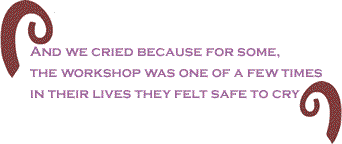
Working in conjunction with the “Politic of silence” is what
African-American women historically created as a "culture of dissemblance" and "the
politic of respectability," the silence African-American women created
around their bodies and sexuality that had been exploited during slavery
was viewed as a revolutionary act against the white oppressive gaze.
The "culture of dissemblance" was a proactive black feminist
politic that aimed to protect the sanctity of the interior aspects
of African-American
women's social and sexual lives. Darlene Clark Hines, professor of history
at Northwestern University and editor of Black
Women in America: An Historical Encyclopedia ,
defines this culture as "the behavior and attitudes of black women that
created the appearance of openness and disclosure but actually shielded the
truth of their inner lives and selves from their oppressor."Only
with secrecy could African-American women achieve the psychic and sexual
space
to protect their bodies and sexuality.
,
defines this culture as "the behavior and attitudes of black women that
created the appearance of openness and disclosure but actually shielded the
truth of their inner lives and selves from their oppressor."Only
with secrecy could African-American women achieve the psychic and sexual
space
to protect their bodies and sexuality.
Evelyn Brooks Higginbotham, professor of history at Harvard University and
author of Righteous Discount: The Women's Movement in the Black Baptist
Church, 1880-1920, points out that the "politics of respectability" emphasized
reform of personal behavior and attitudes both as a goal in itself and
as a strategy for reform of the entire structural system of American
race relations.
Higginbotham also points out that through the discourse of respectability,
the women's movement in the black Baptist Church emphasized manners and
morals while simultaneously asserting traditional forms of protest, such
as petitions,
boycotts, and verbal appeals to justice.
African-American women are no more promiscuous than white women, however,
stereotypes about African-American women's bodies and sexualitities prevent
the proper prevention and education needed to stem the tide of HIV/AIDS.
The iconography of black women is predicated on four racist cultural
images: the Jezebel, the Sapphire, Aunt Jemima, and Mammy. With the
image of the
strong black women who can endure anything and "make a way out of no
way," her strength is either demonized as being emasculating of black
men or impervious to the human condition. The Aunt Jemima and Mammy stereotypes
are now conflated into what's called "Big Mamma" in today's
present iconography of racist and sexist images of African-American women.
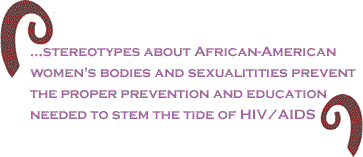
While the Aunt Jemima and Mammy stereotypes are prevalent
images that derive from slavery, for centuries both of them
have not only been threatening,
comforting and nurturing to white culture but also to African-American
men. The dominant culture doesn't see and hear African-American
voices on this
issue because our humanity is distorted and made invisible through
a prism of racist and sexist stereotypes. So too is our suffering.

But the suffering can stop by breaking the silence with SISTA (Sisters
Informing Sisters About Topics on AIDS), an intervention program
that helps African American women reduce their risky sexual
behaviors,
and WILLOW (Women Involved in Life Learning from Other Women),
an intervention program for women living with HIV.
BlackCommentator.com Editorial Board member, the Rev. Irene Monroe is
a religion columnist, theologian, and public speaker. A
native of Brooklyn, Rev. Monroe is a graduate from Wellesley
College and Union Theological Seminary at Columbia University,
and served as a pastor at an African-American church before
coming to Harvard Divinity School for her doctorate as
a Ford Fellow. Reverend Monroe’s “Let
Your Light Shine Like a Rainbow 365 Days a Year - Meditations
on Bible Prayers" will be out in June, 2008. As
an African American feminist theologian, she speaks for
a sector of society that is frequently invisible. Her website
is irenemonroe.com. Click
here to contact the Rev. Monroe.


